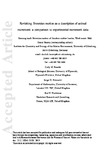Revisiting Brownian motion as a description of animal movement: a comparison to experimental movement data
| dc.contributor.author | Bearup, D | |
| dc.contributor.author | Benefer, Carly | |
| dc.contributor.author | Petrovskii, SV | |
| dc.contributor.author | Blackshaw, RP | |
| dc.date.accessioned | 2016-07-13T14:51:57Z | |
| dc.date.accessioned | 2016-07-14T11:49:07Z | |
| dc.date.accessioned | 2016-07-14T14:03:08Z | |
| dc.date.accessioned | 2016-08-01T12:54:18Z | |
| dc.date.available | 2016-07-13T14:51:57Z | |
| dc.date.available | 2016-07-14T11:49:07Z | |
| dc.date.available | 2016-07-14T14:03:08Z | |
| dc.date.available | 2016-08-01T12:54:18Z | |
| dc.date.issued | 2016-07-05 | |
| dc.identifier.issn | 2041-210X | |
| dc.identifier.issn | 2041-210X | |
| dc.identifier.uri | http://hdl.handle.net/10026.1/5149 | |
| dc.description | File embargoed until 31-07-2017 (publisher's embargo period). | |
| dc.description | Merged with duplicate records 10026.1/5055, 10026.1/5060, 10026.1/5061 and 10026.1/5151 on 01.02.2017 by CS (TIS) | |
| dc.description.abstract |
<jats:title>Summary</jats:title><jats:p> <jats:list> <jats:list-item><jats:p>Characterization of patterns of animal movement is a major challenge in ecology with applications to conservation, biological invasions and pest monitoring. Brownian random walks, and diffusive flux as their mean field counterpart, provide one framework in which to consider this problem. However, it remains subject to debate and controversy. This study presents a test of the diffusion framework using movement data obtained from controlled experiments.</jats:p></jats:list-item> <jats:list-item><jats:p>Walking beetles (<jats:italic>Tenebrio molitor</jats:italic>) were released in an open circular arena with a central hole and the number of individuals falling from the arena edges was monitored over time. These boundary counts were compared, using curve fitting, to the predictions of a diffusion model. The diffusion model is solved precisely, without using numerical simulations.</jats:p></jats:list-item> <jats:list-item><jats:p>We find that the shape of the curves derived from the diffusion model is a close match to those found experimentally. Furthermore, in general, estimates of the total population obtained from the relevant solution of the diffusion equation are in excellent agreement with the experimental population. Estimates of the dispersal rate of individuals depend on how accurately the initial release distribution is incorporated into the model.</jats:p></jats:list-item> <jats:list-item><jats:p>We therefore show that diffusive flux is a very good approximation to the movement of a population of <jats:italic>Tenebrio molitor</jats:italic> beetles. As such, we suggest that it is an adequate theoretical/modelling framework for ecological studies that account for insect movement, although it can be context specific. An immediate practical application of this can be found in the interpretation of trap counts, in particular for the purpose of pest monitoring.</jats:p></jats:list-item> </jats:list> </jats:p> | |
| dc.format.extent | 1525-1537 | |
| dc.language | en | |
| dc.publisher | Wiley | |
| dc.relation.replaces | http://hdl.handle.net/10026.1/5055 | |
| dc.relation.replaces | 10026.1/5055 | |
| dc.relation.replaces | http://hdl.handle.net/10026.1/5060 | |
| dc.relation.replaces | 10026.1/5060 | |
| dc.relation.replaces | http://hdl.handle.net/10026.1/5061 | |
| dc.relation.replaces | 10026.1/5061 | |
| dc.relation.isreplacedby | 10026.1/5151 | |
| dc.relation.isreplacedby | http://hdl.handle.net/10026.1/5151 | |
| dc.subject | diffusion | |
| dc.subject | population flux | |
| dc.subject | random walk | |
| dc.subject | Tenebrio molitor | |
| dc.subject | trapping | |
| dc.title | Revisiting Brownian motion as a description of animal movement: a comparison to experimental movement data | |
| dc.type | journal-article | |
| dc.type | Journal Article | |
| plymouth.author-url | https://www.webofscience.com/api/gateway?GWVersion=2&SrcApp=PARTNER_APP&SrcAuth=LinksAMR&KeyUT=WOS:000390408700011&DestLinkType=FullRecord&DestApp=ALL_WOS&UsrCustomerID=11bb513d99f797142bcfeffcc58ea008 | |
| plymouth.issue | 12 | |
| plymouth.volume | 7 | |
| plymouth.publication-status | Published | |
| plymouth.journal | Methods in Ecology and Evolution | |
| dc.identifier.doi | 10.1111/2041-210X.12615 | |
| plymouth.organisational-group | /Plymouth | |
| plymouth.organisational-group | /Plymouth/Faculty of Science & Engineering | |
| plymouth.organisational-group | /Plymouth/Faculty of Science & Engineering/School of Biological Sciences | |
| plymouth.organisational-group | /Plymouth/Research Centres | |
| plymouth.organisational-group | /Plymouth/Research Centres/Centre for Agricultural and Rural Sustainability (CARS) | |
| dcterms.dateAccepted | 2016-06-02 | |
| dc.rights.embargodate | 2017-7-5 | |
| dc.identifier.eissn | 2041-210X | |
| rioxxterms.versionofrecord | 10.1111/2041-210X.12615 |


